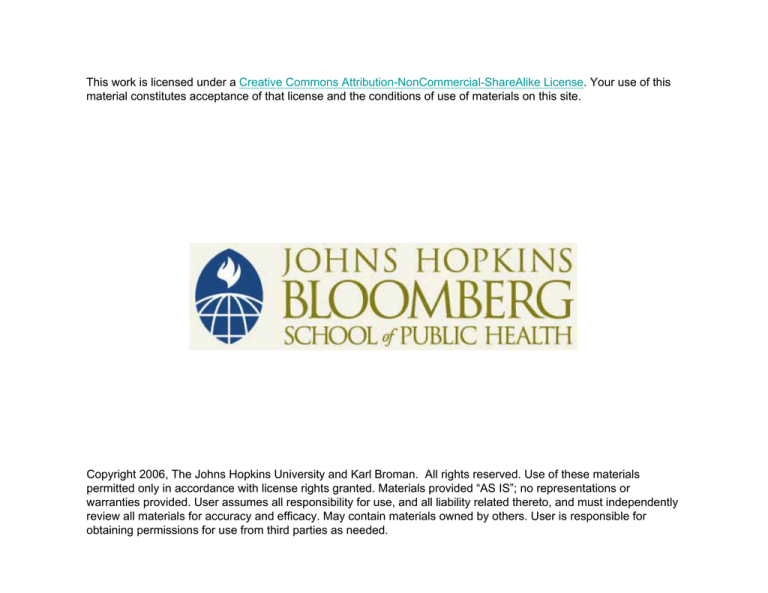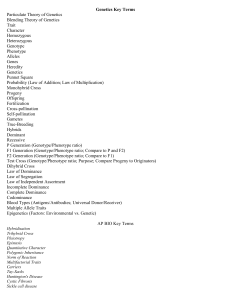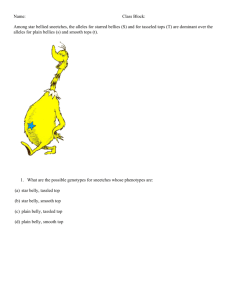
This work is licensed under a Creative Commons Attribution-NonCommercial-ShareAlike License. Your use of this
material constitutes acceptance of that license and the conditions of use of materials on this site.
Copyright 2006, The Johns Hopkins University and Karl Broman. All rights reserved. Use of these materials
permitted only in accordance with license rights granted. Materials provided “AS IS”; no representations or
warranties provided. User assumes all responsibility for use, and all liability related thereto, and must independently
review all materials for accuracy and efficacy. May contain materials owned by others. User is responsible for
obtaining permissions for use from third parties as needed.
Uses and abuses of tests
• Report the P-value
• Report a confidence interval
• Consider the model
• Consider the study design
• Be careful about data snooping
Was the result significant?
• In genetics, people often talk about
“suggestive”
5% < P < 10%
“significant”
1% < P < 5%
“highly significant”
P < 1%
I despise this!
• Hard-and-fast rules are bad
P = 4.8% is essentially the same as P = 5.3%.
• Give the actual P-value, and treat it as a measure of evidence.
Was the result important?
• Statistically significant is not the same as important.
• A difference is “statistically significant” if it cannot reasonably be ascribed to chance variation.
• With lots of data, small (and unimportant) differences can
be statistically significant.
• With very little data, quite important differences will fail to
be significant.
• Always report a confidence interval!
Consider: 0.5 ± 0.1 vs. 100 ± 40
Failure to reject
• Failure to reject the null hypothesis does not mean you
should accept the null hypothesis.
• The means of two populations can always reasonably be
slightly different—it’s impossible to prove, “They are the
same,” though we can say, “They are not too different.”
• Think about the power of the statistical test.
• Look at the confidence interval.
Statisticians as cops
• Don’t think of statistics as a barrier to publishing important
work.
• Rather, think of statistics as help for avoiding publishing
garbage.
• Statistics can help you to avoid wasting time (and money)
following false leads.
The role of the model
Population
0
10 µ 20
30
Data
40
50
0
10X
20
30
40
50
• Statistical tests and confidence intervals concern inferences
about a (possibly hypothetical) population on the basis of
data.
• Model: X 1, . . . , X n independent with mean µ and SD σ .
• For a well-designed (randomized) experiment, this is usually not a worry.
• Be suspicious about statistical tests with censuses and
convenience samples.
Does the difference prove the point?
• A test of significance doesn’t check the design of the study.
• With observational studies or poorly controlled experiments,
the proof of statistical significance may not prove what you
want.
• Example: consider the tick/deer leg experiment. It may
be that ticks are not attracted to deer-gland-substance but
rather despise the scent of latex gloves and deer-glandsubstance masks it.
• Example: In a study of gene expression, if cancer tissue
samples were always processed first, while normal tissue
samples were kept on ice, the observed differences might
not have to do with normal/cancer as with iced/not iced.
• Don’t forget the science in the cloud of data and statistics.
Data snooping / Multiple testing
• Generally we perform more than one statistical test at once.
• If you are performing many statistical tests, and then reporting the interesting ones, take care!
You need to adjust for the fact that you are performing
many tests.
• Sometimes investigators study their data, and then apply
formal statistical tests only to features that appear interesting (and likely statistically significant).
Take care! They should adjust for the statistical tests that
they applied informally, in snooping through their data.
• Ideally, such multiple statistical tests are treated as exploratory, and the interesting results are confirmed with
independent data.
Backcross experiment
P1
P2
F1
AA
BB
AB
BC
BC
BC
BC
Phenotype distributions
Parental strains
• Within each of the parental
and F1 strains, individuals are
genetically identical.
0
20
• Environmental variation may
or may not be constant with
genotype.
• The backcross generation exhibits genetic as well as environmental variation.
40
60
80
100
80
100
F1 generation
0
20
40
60
Backcross generation
0
20
40
60
Phenotype
80
100
Data and Goals
Phenotypes:
Genotypes:
yi = phenotype for mouse i
xij = 1/0 if mouse i is BB/AB at marker j
(for a backcross)
Locations of markers
Genetic map:
Goals:
• Identify the (or at least one) genomic regions
(QTLs) that contribute to variation in the
phenotype.
• Form confidence intervals for QTL locations.
• Estimate QTL effects.
Genetic map
0
20
Location (cM)
40
60
80
100
1
2
3
4
5
6
7
8
9
10
11
Chromosome
12
13
14
15
16
17
18
19
Missing genotypes
1
3
2
4
5
6
8
7
9
10
11
12
13
14
15
16 17 18 19
120
100
Individuals
80
60
40
20
20
40
60
80
100
120
Markers
The simplest method: t-tests
• Split mice into groups
according to genotype
at a marker.
80
• Do a t-test
• Repeat for each marker.
Phenotype
70
60
50
40
BB
AB
Genotype at D1M30
BB
AB
Genotype at D2M99
3.0
2.5
|T|
2.0
1.5
1.0
0.5
0.0
1
2
3
4
5
6
7
8
9
10
11
12
13
14 15
16
17 18 19
Adjustment for multiple tests
• We performed a t-test at each of 91 markers. (The markers are, of course, associated.)
• The maximum t-statistic was 3.05. What P-value do we
assign to this?
Nominal P-value = Percentile of |T| (under null hypothesis)
= 0.002
Adjusted P-value = Percentile of maximum |T| (under null
hypothesis of no QTLs anywhere)
• How to get at the distribution of the maximum |T|, genomewide? I like permutation tests. They require heavy computation, but they’re trustworthy.
Permutation tests
phenotypes
markers
T (z)
(a set of t-statistics)
genotype
data
mice
-
M=
max |T (z)|
-
• Permute/shuffle the phenotypes; keep the genotype data intact.
• Calculate |T ?(z)| −→ M ? = maxz |T ?(z)|
• We wish to compare the observed M to the distribution of M ?.
• Pr(M ? ≥ M ) is a genome-wide P-value.
• The 95th %ile of M ? is a genome-wide critical value
• We can’t look at all n! possible permutations, but a random set of 1000 is feasible and provides reasonable estimates of P-values and critical values
Permutation distribution
Observed max |T|
Area to right = 7%
0
1
2
3
max |T|
4
Uses and abuses of tests
• Report the P-value
• Report a confidence interval
• Consider the model
• Consider the study design
• Be careful about data snooping









